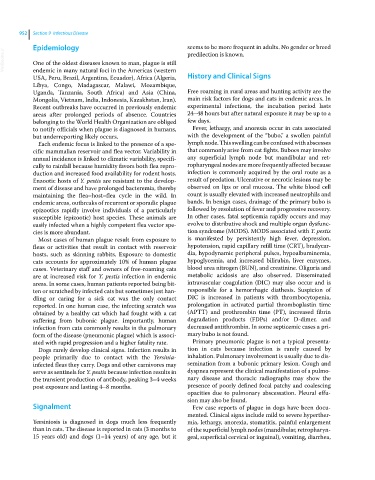Page 1014 - Clinical Small Animal Internal Medicine
P. 1014
952 Section 9 Infectious Disease
Epidemiology seems to be more frequent in adults. No gender or breed
VetBooks.ir One of the oldest diseases known to man, plague is still predilection is known.
endemic in many natural foci in the Americas (western
USA, Peru, Brazil, Argentina, Ecuador), Africa (Algeria, History and Clinical Signs
Libya, Congo, Madagascar, Malawi, Mozambique,
Uganda, Tanzania, South Africa) and Asia (China, Free roaming in rural areas and hunting activity are the
Mongolia, Vietnam, India, Indonesia, Kazakhstan, Iran). main risk factors for dogs and cats in endemic areas. In
Recent outbreaks have occurred in previously endemic experimental infections, the incubation period lasts
areas after prolonged periods of absence. Countries 24–48 hours but after natural exposure it may be up to a
belonging to the World Health Organization are obliged few days.
to notify officials when plague is diagnosed in humans, Fever, lethargy, and anorexia occur in cats associated
but underreporting likely occurs. with the development of the “bubo,” a swollen painful
Each endemic focus is linked to the presence of a spe lymph node. This swelling can be confused with abscesses
cific mammalian reservoir and flea vector. Variability in that commonly arise from cat fights. Buboes may involve
annual incidence is linked to climatic variability, specifi any superficial lymph node but mandibular and ret
cally to rainfall because humidity favors both flea repro ropharyngeal nodes are more frequently affected because
duction and increased food availability for rodent hosts. infection is commonly acquired by the oral route as a
Enzootic hosts of Y. pestis are resistant to the develop result of predation. Ulcerative or necrotic lesions may be
ment of disease and have prolonged bacteremia, thereby observed on lips or oral mucosa. The white blood cell
maintaining the flea–host–flea cycle in the wild. In count is usually elevated with increased neutrophils and
endemic areas, outbreaks of recurrent or sporadic plague bands. In benign cases, drainage of the primary bubo is
epizootics rapidly involve individuals of a particularly followed by resolution of fever and progressive recovery.
susceptible (epizootic) host species. These animals are In other cases, fatal septicemia rapidly occurs and may
easily infected when a highly competent flea vector spe evolve to distributive shock and multiple organ dysfunc
cies is more abundant. tion syndrome (MODS). MODS associated with Y. pestis
Most cases of human plague result from exposure to is manifested by persistently high fever, depression,
fleas or activities that result in contact with reservoir hypotension, rapid capillary refill time (CRT), bradycar
hosts, such as skinning rabbits. Exposure to domestic dia, hypodynamic peripheral pulses, hypoalbuminemia,
cats accounts for approximately 10% of human plague hypoglycemia, and increased bilirubin, liver enzymes,
cases. Veterinary staff and owners of free‐roaming cats blood urea nitrogen (BUN), and creatinine. Oliguria and
are at increased risk for Y. pestis infection in endemic metabolic acidosis are also observed. Disseminated
areas. In some cases, human patients reported being bit intravascular coagulation (DIC) may also occur and is
ten or scratched by infected cats but sometimes just han responsible for a hemorrhagic diathesis. Suspicion of
dling or caring for a sick cat was the only contact DIC is increased in patients with thrombocytopenia,
reported. In one human case, the infecting scratch was prolongation in activated partial thromboplastin time
obtained by a healthy cat which had fought with a cat (APTT) and prothrombin time (PT), increased fibrin
suffering from bubonic plague. Importantly, human degradation products (FDPs) and/or D‐dimer, and
infection from cats commonly results in the pulmonary decreased antithrombin. In some septicemic cases a pri
form of the disease (pneumonic plague) which is associ mary bubo is not found.
ated with rapid progression and a higher fatality rate. Primary pneumonic plague is not a typical presenta
Dogs rarely develop clinical signs. Infection results in tion in cats because infection is rarely caused by
people primarily due to contact with the Yersinia‐ inhalation. Pulmonary involvement is usually due to dis
infected fleas they carry. Dogs and other carnivores may semination from a bubonic primary lesion. Cough and
serve as sentinels for Y. pestis because infection results in dyspnea represent the clinical manifestation of a pulmo
the transient production of antibody, peaking 3–4 weeks nary disease and thoracic radiographs may show the
post exposure and lasting 4–8 months. presence of poorly defined focal patchy and coalescing
opacities due to pulmonary abscessation. Pleural effu
sion may also be found.
Signalment Few case reports of plague in dogs have been docu
mented. Clinical signs include mild to severe hyperther
Yersiniosis is diagnosed in dogs much less frequently mia, lethargy, anorexia, stomatitis, painful enlargement
than in cats. The disease is reported in cats (3 months to of the superficial lymph nodes (mandibular, retropharyn
15 years old) and dogs (1–14 years) of any age, but it geal, superficial cervical or inguinal), vomiting, diarrhea,

